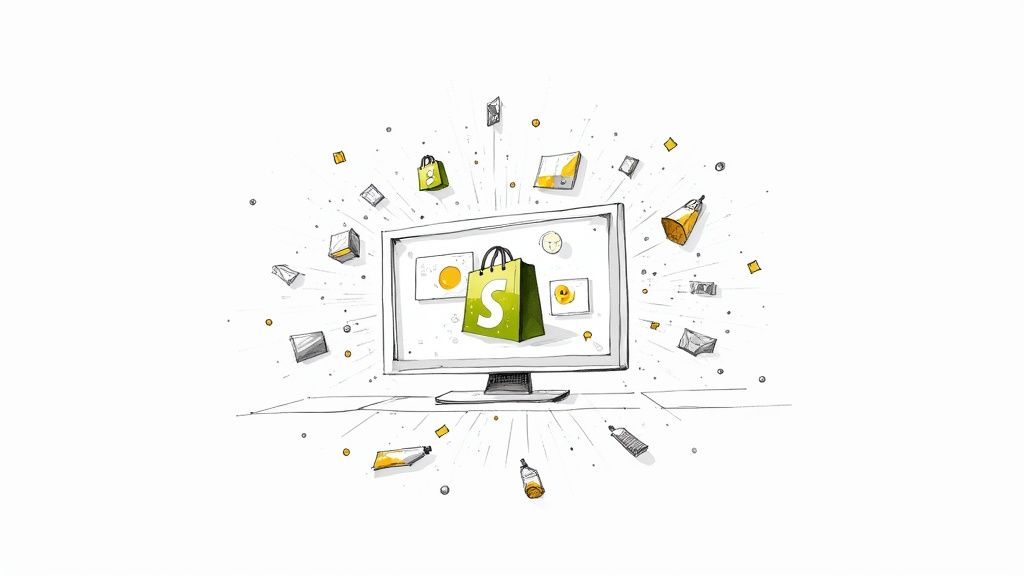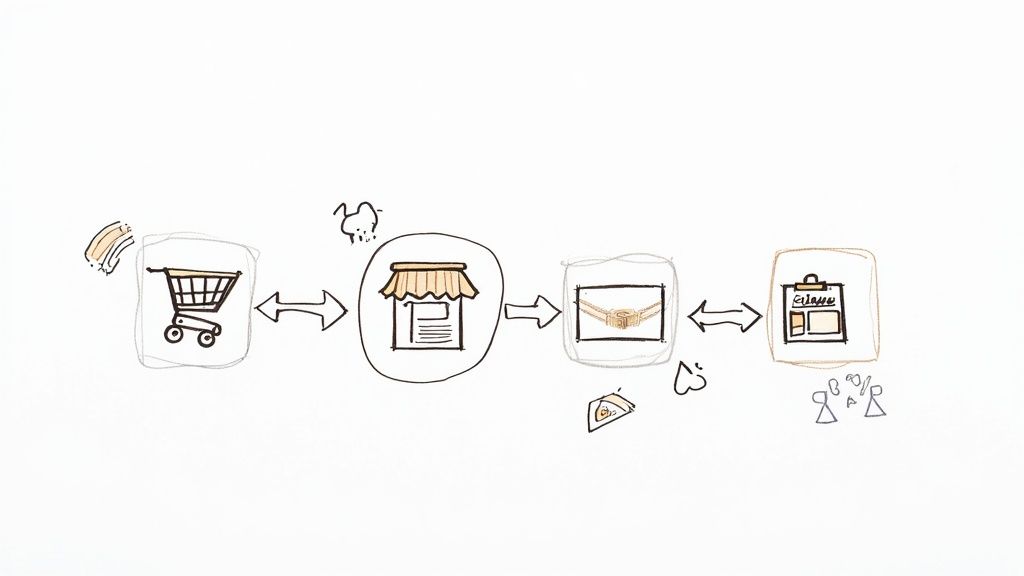Understanding the Power of Shopify Commerce

Shopify has become one of the most popular platforms for online stores, and for good reason. The platform makes it simple for businesses of all sizes to sell online effectively. Let's explore what makes Shopify stand out and why so many business owners choose it for their online stores.
The All-In-One E-Commerce Solution
What makes Shopify special is how it brings everything together in one place. Store owners can manage their products, process payments, and ship orders all from a single dashboard. This means less time jumping between different tools and more time focusing on growing your business. The simple interface makes daily tasks like updating inventory and fulfilling orders much easier.
Scalability and Flexibility
One of Shopify's biggest strengths is how well it grows with your business. Whether you're just starting out or running a large operation, the platform adjusts to fit your needs. Small businesses can start with basic features and add more as they grow. The different pricing plans make it easy to find an option that works for your current size and budget.
A Thriving Ecosystem
Beyond the core features, Shopify's App Store offers thousands of add-ons to enhance your store. Need better email marketing? There's an app for that. Want to improve your customer service? You'll find plenty of options. These apps let you customize your store to match exactly what your business needs. Many store owners use apps to automate routine tasks or add features their customers want.
The numbers tell a clear story about Shopify's success. Since starting in 2006, the platform hit its first major milestone in 2013 with $1 billion in sales. Fast forward to 2023, and Shopify processed an impressive $235.91 billion in online sales – up 19.65% from the year before. Today, over 2 million businesses trust Shopify to run their online stores. For more details about Shopify's growth, check out these detailed statistics on Backlinko.
Key Takeaways for Success
To get the most out of your Shopify store, focus on these essential areas:
- Know your customers: Build your store around what your target audience wants and needs
- Make buying easy: Design your store with clear navigation and simple checkout
- Use helpful apps: Pick apps that solve real problems for your business
- Keep learning: Stay informed about new Shopify features that could help your store
By focusing on these basics, you can build a successful online store with Shopify. The platform gives you all the tools you need – the rest comes down to how well you use them to serve your customers and grow your business.
Building Your High-Converting Shopify Store

Creating a successful online store takes more than just adding products to your Shopify site. You need a clear plan for setting up, designing, and fine-tuning your store to turn visitors into customers. Let's walk through the key steps to build a store that actually sells.
Choosing the Right Theme and Design
Your store's theme sets the tone for how customers experience your brand. Think of it like the layout and atmosphere of a physical store – it needs to feel inviting and make shopping easy. When picking a theme, focus on mobile-friendly designs that load quickly and match your brand's style. For instance, a luxury skincare brand might want a clean, minimal look, while a toy store could use bright colors and playful elements.
The details of your design can make or break sales. Place your "Buy Now" buttons where they're easy to spot, use clear product photos, and make navigation straightforward. Every element should guide visitors naturally toward making a purchase, just like well-placed signs in a brick-and-mortar store.
Organizing Your Product Catalog and Payment System
A messy product catalog is like a disorganized store shelf – it frustrates shoppers and sends them elsewhere. Group your items in ways that make sense, use clear product names, and add helpful tags. This makes it simple for customers to find what they want and helps your store show up in search results.
The checkout process needs to be smooth and trustworthy. Give customers several ways to pay, including familiar options like PayPal and Apple Pay. Be upfront about shipping costs and delivery times – hidden fees at checkout are a sure way to lose sales.
Optimizing Navigation and Checkout
Good navigation helps customers find their way around your store without getting lost or frustrated. Use clear menu labels, breadcrumb trails, and helpful links between related products. Think of it like placing clear aisle markers in a supermarket – it helps shoppers get where they want to go quickly.
Your checkout page is where window shoppers become paying customers. Keep it simple by removing unnecessary steps and offering guest checkout. Show security badges and guarantees prominently to build confidence. The goal is to make checking out as quick and painless as possible.
Using Customer Data to Improve
Your store generates valuable information about how people shop. Watch your traffic patterns, see where customers drop off, and notice which products get the most attention. For example, if many shoppers abandon their carts when they see shipping costs, you might need to adjust your shipping strategy. This real-world feedback shows you exactly what needs fixing in your store.
Pay special attention to your conversion rate – the percentage of visitors who make a purchase. Look for patterns in successful sales and common roadblocks. Each piece of data gives you clues about how to make your store better at turning browsers into buyers.
Crafting Product Pages That Convert

Your product pages are where most sales happen in your online store. Getting these pages right can make the difference between losing visitors and turning them into happy customers. The key is understanding what makes shoppers click "buy" and presenting your products in a way that connects with their needs.
Writing Persuasive Product Descriptions
Good product descriptions tell a story and show real benefits. Instead of just listing features, explain how your product solves problems. For example, rather than saying "Made of durable material," try "Our weather-resistant nylon bag keeps your belongings safe and dry through rain, snow, and daily use." This directly addresses common customer concerns about durability.
Use vivid, sensory language to help shoppers imagine owning and using your product. Paint a clear picture of how it fits into their daily life, going beyond basic specs to create an emotional connection that drives purchases.
Optimizing Product Photography and Visuals
Clear, high-quality photos are essential for showing off your products. Include multiple angles and close-up shots so customers can examine details just like they would in a physical store. Research shows that 83% of online shoppers consider product images the most important factor in making purchase decisions.
You don't need an expensive camera setup to take good product photos. With some natural light, a plain background, and a recent smartphone, you can capture professional-looking images. Free photo editing tools can help polish them further.
Implementing Pricing and Social Proof Strategies
Smart pricing can boost your average order value significantly. Try offering bundle deals or quantity discounts – for instance, "Buy 2, Save 15%" encourages larger purchases while still protecting your margins.
Show off customer reviews and ratings prominently – 92% of shoppers read reviews before buying. Adding features like "Customers also bought…" can naturally guide visitors to related products they might like, increasing cart size without being pushy.
Creating a Sense of Urgency
Limited-time offers and low-stock alerts can encourage faster purchasing decisions. But use these carefully – too much pressure can seem fake and drive customers away. Focus on genuine scarcity and real value, like truly limited edition items or seasonal products that won't be restocked.
Remember to test different approaches and track what works best for your specific products and customers. Small tweaks to your product pages can lead to big improvements in your conversion rates over time.
Growing Your Store With Smart Marketing Tools

Growing an online store takes more than just listing products – it requires smart marketing that attracts and keeps customers coming back. By combining Shopify's built-in tools with other proven marketing solutions, you can create a system that builds real connections with shoppers. Let's look at the key elements that make up an effective marketing approach.
Email Marketing That Gets Results
Email continues to be one of the best ways to stay in touch with customers. While Shopify includes basic email features, connecting with specialized email platforms opens up more possibilities. You can set up automatic emails that respond to specific customer actions. For instance, send a friendly welcome note to new subscribers, remind shoppers about items left in their cart, or follow up after purchases to encourage reviews and repeat orders. This kind of personal touch helps build lasting customer relationships.
Smart Social Media That Brings in Buyers
Getting traffic from social media is key, but it needs to be the right kind of traffic. The most successful stores focus on attracting people who are likely to buy, not just random visitors. This means knowing exactly who your ideal customers are, finding them on the social platforms they use most, and creating posts they'll actually want to engage with. Well-targeted social media ads can help you reach more of these potential buyers.
Customer Groups for Better Marketing
Breaking your customer base into specific groups helps you market more effectively. You might group people based on what they buy, how they shop, or how often they purchase. This lets you send messages that really connect with each group. You could offer special deals to your most loyal customers or suggest products to people based on their past purchases. When marketing feels more personal and relevant, more people tend to buy.
Making Decisions Based on Real Data
Shopify gives you tools to see how your store is performing, but the real value comes from using this information to improve. Look at important numbers like website visits, sales rates, and customer acquisition costs. Then use what you learn to make your marketing better. For example, if you see most of your sales coming from one type of ad, you might want to focus more of your budget there.
Getting More From Your Ad Budget
Making your advertising dollars work harder takes constant attention and adjustment. Watch how your ads perform by tracking click rates, conversion numbers, and cost per sale. Use this information to fine-tune your approach – maybe you need to adjust who sees your ads, try different images, or change your message. Test different versions of your ads to see what works best. When you regularly check and improve your campaigns, you get better results without spending more money. This focused approach helps turn your marketing budget into actual sales growth.
Mastering Advanced Shopify Features
While most merchants use Shopify's basic features, the platform offers much more under the surface. Understanding and implementing these advanced capabilities can make a real difference in how your store performs and grows.
Optimizing Inventory Management for Shopify Commerce
Smart inventory management directly impacts your bottom line. The key is finding the sweet spot between having enough stock to meet demand without tying up excess capital. Shopify's inventory tools help you hit this balance through:
- Automated reorder points
- Real-time stock tracking across channels
- Sales trend analysis for better forecasting
When connected with specialized inventory apps, these features work together to prevent both costly stockouts and overstock situations.
Expanding Your Reach With Multi-Channel Selling
Your online store is just the beginning. Multi-channel selling opens up new markets and revenue streams by connecting your Shopify products to where customers already shop. You can sync your inventory and orders across:
- Major marketplaces like Amazon and eBay
- Social platforms like Facebook and Instagram
- Physical retail locations with Shopify POS
This approach lets you manage everything from one dashboard while reaching customers wherever they prefer to shop.
Crafting a Customized Checkout Experience
The checkout process can make or break a sale. Shopify lets you fine-tune this critical step to match your brand and customer needs. Consider adding:
- Express payment options like Apple Pay and Shop Pay
- Custom fields for important order details
- Branded design elements that build trust
Small improvements here often lead to significant drops in cart abandonment and higher conversion rates.
Leveraging Shopify Apps for Enhanced Functionality
The Shopify App Store contains thousands of tools to enhance your store. The trick is choosing apps that truly serve your business goals. Before installing any app, ask:
- Does it solve a specific problem?
- What do the reviews and ratings tell you?
- Is the price justified by the potential return?
Focus on apps that directly improve your operations or customer experience, rather than adding features just because they're available.
Identifying High-ROI Features for Your Business Model
The most valuable Shopify features depend entirely on your specific business needs. A dropshipping store might focus on automation tools, while a subscription business needs recurring payment features. Start by examining your biggest operational challenges:
- What tasks take up most of your time?
- Where do customers often get stuck?
- Which processes could be automated?
Match these pain points to specific Shopify features and apps. Track the impact of each new tool you implement to ensure it delivers real value for your investment. This focused approach helps you build a truly efficient store that serves both your team and your customers better.
Scaling Your E-Commerce Operations
Growing your Shopify store requires both strategic planning and smart execution. Success means more than just watching sales numbers climb – you need strong systems to support growth while keeping customers happy. Let's explore the key areas to focus on as you expand your business.
Handling Increased Order Volumes Efficiently
When orders start pouring in, you need smooth processes to keep up. Just like a restaurant kitchen scaling up for more diners, your fulfillment systems need strategic upgrades. This could mean partnering with a 3PL (third-party logistics) provider to manage warehousing and shipping, or setting up automated order processing through Shopify's built-in tools.
Maintaining Customer Satisfaction During Growth
Quality customer service becomes even more important as you grow. To keep providing personal attention at scale, invest in tools that help track and manage customer interactions effectively. A good customer relationship management (CRM) system lets you maintain detailed records of preferences and past purchases. You can also set up automated responses for common questions, freeing up your team to focus on complex support needs.
Expanding Into International Markets Strategically
Selling internationally can boost your revenue significantly, but requires careful planning. Each new market brings unique languages, currencies, and regulations to navigate. While Shopify provides helpful features like multi-currency support, success often depends on working with local experts who understand each market's specific needs and customs.
Building Systems for Sustainable Growth
Long-term success requires systems that can adapt as your business evolves. Regular analysis of your data helps identify bottlenecks and opportunities. For example, sales patterns might show that certain products consistently underperform, letting you adjust inventory or marketing approaches accordingly. This ongoing refinement keeps your business running smoothly as you scale.
Inventory Management at Scale
Good inventory management becomes critical as your business grows. Like preparing for a large catering event, you need to know exactly what's in stock at all times. A robust inventory system integrated with your Shopify store provides real-time stock levels, helping you avoid both stockouts and excess inventory. This visibility lets you set smart reorder points and meet customer demand consistently.
Customer Service Automation That Maintains Quality
While automation helps handle growing volume, keep the human touch in your customer service. Think of automated responses as a first step – they handle basic questions quickly, but customers should easily reach a person for complex issues. This balanced approach maintains efficiency without sacrificing the personal connection that builds loyalty.
Operational Frameworks to Prevent Growing Pains
Growth brings challenges, but clear operational frameworks help manage them effectively. Create detailed documentation for key processes, define team roles clearly, and establish regular communication channels. These structures help your organization stay flexible and resilient while handling increased complexity.
Successfully scaling your Shopify store requires careful attention to these fundamental areas. By building strong systems now, you create a foundation for sustainable growth and long-term success.
Ready to improve your Shopify marketing and optimize your ad campaigns? MyAdForce helps simplify your sales funnels and advertising strategy. Learn more about how MyAdForce can help grow your Shopify business

Laisser un commentaire